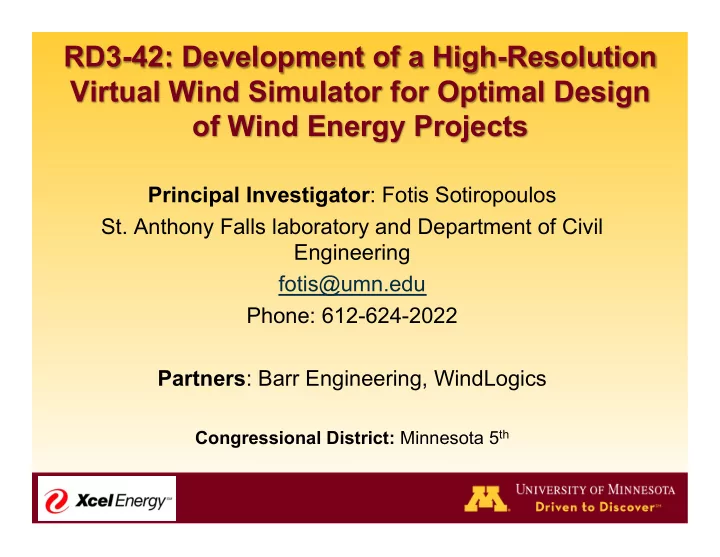

RD3-42: Development of a High-Resolution Virtual Wind Simulator for Optimal Design of Wind Energy Projects Principal Investigator : Fotis Sotiropoulos St. Anthony Falls laboratory and Department of Civil Engineering fotis@umn.edu Phone: 612-624-2022 Partners : Barr Engineering, WindLogics Congressional District: Minnesota 5 th
Project Objectives • Develop, validate and demonstrate the capabilities of an advanced high-performance computing ‘ Virtual Wind Simulator ’ ( VWiS ) for predicting atmospheric boundary layer flow and its interactions with wind turbines and wind farms. – Improve the design of potential wind energy projects by providing more accurate predictions of local wind turbulence at site and turbine levels. – Increase the level of wind energy utilization and reduce the cost of energy production. Page 2
Project Tasks 1. Develop the VWiS for high-resolution simulations of wind turbulence and their effect on energy production 2. Validate the VWiS using wind tunnel measurements 3. Test the VWiS using measurements collected at an operational utility-scale wind farm 4. Apply the VWiS to assess wind resources at an undeveloped site with complex terrain Page 3
Task 1: Develop the VWiS Weather Research Forecast Model (WRF) Large-eddy simulation Complex terrain ! Page 4
Task 2: Validate the VWiS with Wind Tunnel Experiments Inflow 2D 5D 10D ! Comparison of VWiS predictions (lines) ! with experiments (circles) Page 5
Task 3: Apply VWiS at an operational wind farm (Mower County) LES WRF ! T39 T40 T41 T42 T43 Measured 2.15 2.14 1.86 1.85 power (MW) Calculated 2.38 2.13 2.75 1.51 2.14 power (MW) ! Page 6
Task 4: Prairie Island wind resource assessment using the VWiS Velocity ! ! Turbulence kinetic energy ! ! ! Page 7
Lessons learned • Simplifying approximations of the turbine geometry with actuator disks or rotating actuator lines can predict turbine power output at utility-scale wind farms with reasonable accuracy. • Extensive wind tunnel experiments combined with strategically collected field measurements provide a feasible and effective approach for validating computational models. • Taking into account atmospheric turbulence effects is extremely important for obtaining accurate wind resource assessment results. • Neglecting turbulence leads to artificially long turbine wakes and can considerably under-predict the performance of utility-scale wind turbines by as high as 60%. Page 8
Lessons learned (cont.) • Arranging turbines in staggered fashion, as compared to the more traditional aligned arrangement, can lead to significant gains in wind farm performance (as high as 10 percent) • Site topography and the complex turbulence it induces can have a profound effect on wind farm performance and needs to be taken into account when deciding turbine placement. • Turbines at Prairie Island need to be installed more than 1km away from the complex terrain and need to be carefully arranged. Page 9
Project benefits • The VWiS provides wind farm developers and operators with a powerful science-based computational tool that can take into account site-specific topography, turbine-atmosphere and turbine-turbine interactions in wind farms. Such effects could not be predicted with existing models. • Reliable computational model for predicting the power output of and dynamic loading on wind turbines in utility-scale wind farms • The ViWS can be used to improve the reliability of existing wind farms by allowing operators to assess turbulence loads on turbines in order to: 1. Identify excessively loaded turbine blades that are likely to fatigue; and 2. Develop proactive maintenance and health monitoring strategies. Page 10
Project benefits (cont.) • The ViWS can provide a powerful tool for future wind project development: – Scientific approach for arranging and spacing wind turbines – Optimize wind farm efficiency and enhance reliability by reducing turbulence loads on blades – Take into account complex terrain and enable the development of wind projects at challenging sites • Benefits to the Xcel Energy ratepayers : – Reduce the cost of energy for new and existing wind farm installations by increasing power production, reducing maintenance costs, and improving turbine designs. – Reduce future energy rates and the need for the federal and state governments to subsidize new wind farm development. – Help Minnesota reach its renewable energy goal (25% by 2025) by advancing wind energy as a major renewable electricity resource Page 11
Thank you! Page 12
Recommend
More recommend